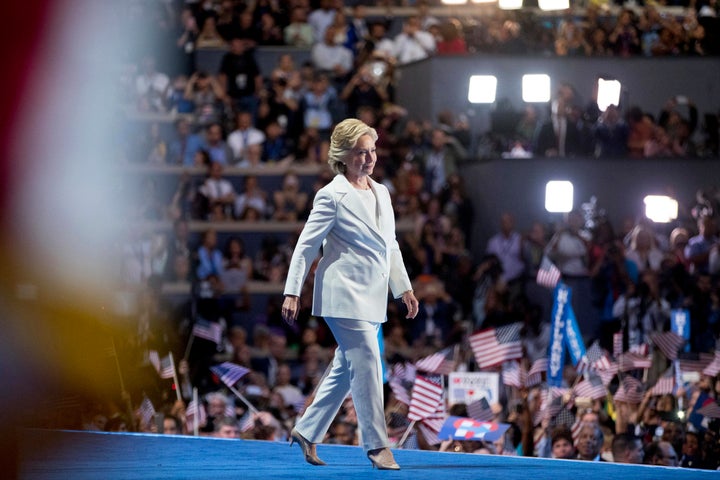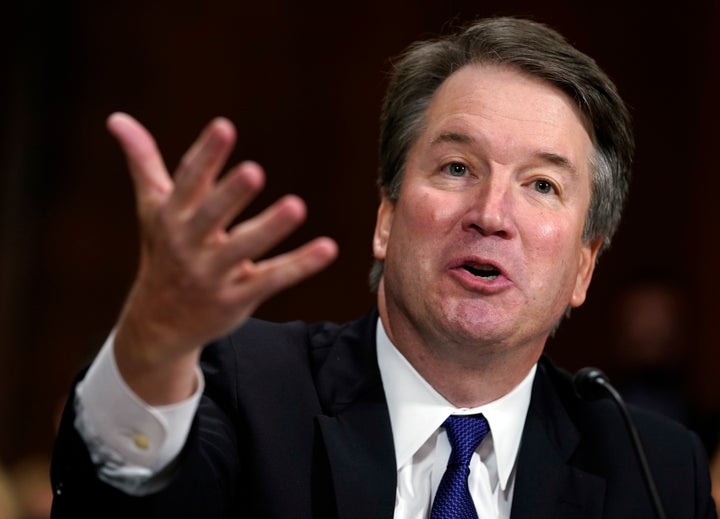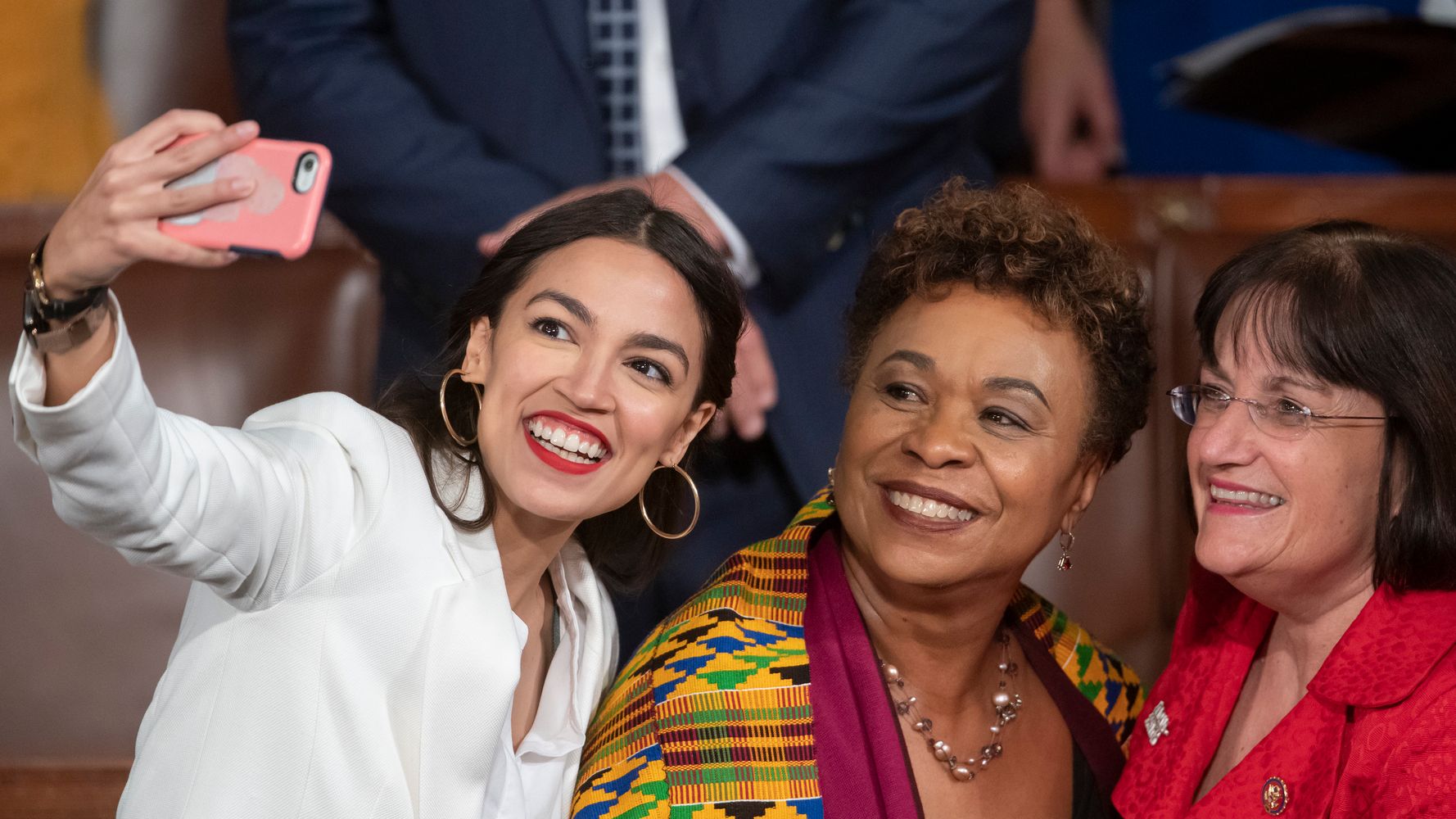[ad_1]
When Alexandria Ocasio-Cortez was sworn in to Congress, she wore a suit of suffragette white. Fashion was an important part of the suffragette movement, a way to push back against stereotypes of women who sought liberation as unfashionable and unattractive. White clothing symbolized the purity of their motives.
Ocasio-Cortez’s other sartorial choices ― bright-red lipstick and hoop earrings ― were worn, she said, in homage to Supreme Court Justice Sonia Sotomayor, who was advised to appear at her confirmation hearing with neutral-colored nail polish, and had refused, keeping her red.
Watching Ocasio-Cortez being sworn in, I couldn’t help but think of a similar outfit ― an all-white pantsuit ― worn by Hillary Clinton, when she officially became the Democratic nominee for president in 2016. Like Ocasio-Cortez, Clinton intentionally set out to echo the suffragettes’ struggle for the vote, and to imbue her clothing choice with an appropriate nod to the historical significance of her achievement.

This week, it was thrilling to watch a new class of House members sworn in, a class that contained more women, a substantial minority of whom were women of color, than ever before in United States history. Nancy Pelosi retook the gavel of the speakership. The unprecedented diversity of the Democratic freshman class was unmissable. Detroit’s Rashida Tlaib inspired Palestinian-Americans to exult on social media by wearing a traditional thobe, and Ilhan Omar, the first Somali-American in Congress, matched an elegant black hijab with a black manicure.
This isn’t just an idle fixation on fashion, a legislative who-wore-it-best. These outfits were selected with evident attention to historical detail, cultural resonance and symbolism. Ocasio-Cortez and others have used historical detail as inspiration for sartorial choices to intentionally echo women who came before them, women who strove for power and attained it. It’s a concrete manifestation of the way representation in the halls of power inspires future generations of leaders. Women in power provide visible, compelling encouragement to other women. They are the evidence, our well-dressed and symbolically accessorized proof, that achieving power is possible.
Watching Congress edge toward fuller representation of half the country’s population is exhilarating. But for me, it’s only created a hunger for more representation. Our nation’s legislature is far from achieving gender parity. Even as the Democrats do a better job of electing leaders who look like the people they’ll lead, the Republican caucus became even whiter and more male in the 2018 midterms. And as the long, long process of the 2020 election begins to rumble into being, I’ve found myself returning to a longing I felt acutely during the agonizing contest of 2016: I want my next president to be a woman.
Women in power provide visible, compelling encouragement to other women. They are the evidence, our well-dressed and symbolically accessorized proof, that achieving power is possible.
I felt it with Clinton’s candidacy: I wanted a member of my gender, for the very first time, to sit behind the Resolute Desk, to guide our nation’s policy, to sign bills into law. I wanted a woman to take her place in the halls of power, and put an end to nearly 250 years of male rule.
Over the long, hotly contested 2016 Democratic primary, I had many occasions to doubt that such a desire was valid. Clinton’s candidacy sparked an unparalleled degree of animus among many on the left. Her cautious, technocratic policies and stiff mannerisms became subjects not only of mockery, but of genuine loathing.
The debates between Clinton’s supporters and those who backed Bernie Sanders became a policy battleground, one in which my natural affinity drifted toward the eminently sensible policies of single-payer health care and free college education. But gender was the undercurrent of all those arguments, the acrid aftertaste I couldn’t shake. Throughout it all, I still wanted a woman president.
In arguments with friends and relatives, I was made to doubt that desire again and again. Wasn’t it shallow? Wasn’t I a “vagina voter� Wasn’t it, paradoxically, sexist to consider gender in my selection of a future president?
I’ve found myself returning to a longing I felt acutely during the agonizing contest of 2016: I want my next president to be a woman.
The arguments revolved on themselves, quickly devolving into bitter tedium. I recognized the real stakes behind the policy arguments ― the accurate diagnosis that, under Obama, progress had been too slow, and Democrats too eager to seek compromise, leaving millions bereft of health care and slipping through the cracks of a slashed social safety net.
But I recognized too a fierce longing in myself, a nearly wild desire to see the “highest, hardest glass ceiling†shattered at last. In Clinton’s general election platform, the lack of ambitious, visionary policies that could measurably better the lives of Americans was palpable. But at the moment she took to the podium at the Democratic National Convention, swathed in white, standing before the nation with the force of centuries of history and longing behind her, I was struck by the undeniable power of the moment. I felt a shiver to my core.
In the last two years, the indignities of that deferred dream have impressed themselves on me with a vengeance. The miasmic swamp we now call our politics is not only the era of Donald Trump, whose treatment of women has always been abhorrent. It’s the era of Brett Kavanaugh, with his blackout beers and the specter of sexual assault. It’s an era of unrelenting assault on women’s health care at home and abroad, with abortion protections hanging in the increasingly precarious balance of the Supreme Court. The near miss of the Clinton loss is all the more painful in an era of the male grotesque.

As the potential for an end to the Trump era ticks closer, female candidates for the presidency are already subjects of buzz and speculation. Elizabeth Warren has announced her candidacy and has already set out to charm the inhabitants of Sioux City, Iowa. Other potential female 2020 Democratic contenders, like Kamala Harris, Amy Klobuchar and Kirsten Gillibrand, have begun, cautiously, exploring runs.
And I’ve found that my desire for representation has not dimmed in the slightest, despite a growing chorus of skeptical voices who wonder if a woman can beat Trump. Its return has surprised me with its ferocity. To see a female president in my lifetime is not an idle wish; it is a hunger, an insatiable desire. Watching the 116th Congress being sworn in was a swelling reminder of what it is to feel represented in my government, but it was also a reminder of how partial those gains have been, and how dear. In a country that has never been led by a woman, how can anyone claim that gender equality is at hand ― or even possible?
I’ve had three years to mull over the 2016 primaries, a subject I never particularly wanted to revisit, but which has a habit of recurring in political conversation like a stench. Questions of centrist versus leftist policies remain complex, and fraught with real consequence for the lives and livelihoods of Americans. But this time, I can’t be talked out of my desire for a woman president. I can’t be gaslit out of it, or told it’s trivial, unnecessary, too much to ask, unimportant. I know in my soul that it is important. Looking down the pale, male corridors of past power, I reflect on centuries of stymied hopes with sorrow, but I look to the future with a terrible and frightening hope in my chest.
Talia Lavin is a writer and researcher based in Brooklyn.
Calling all HuffPost superfans!
Sign up for membership to become a founding member and help shape HuffPost’s next chapter
[ad_2]
Source link





